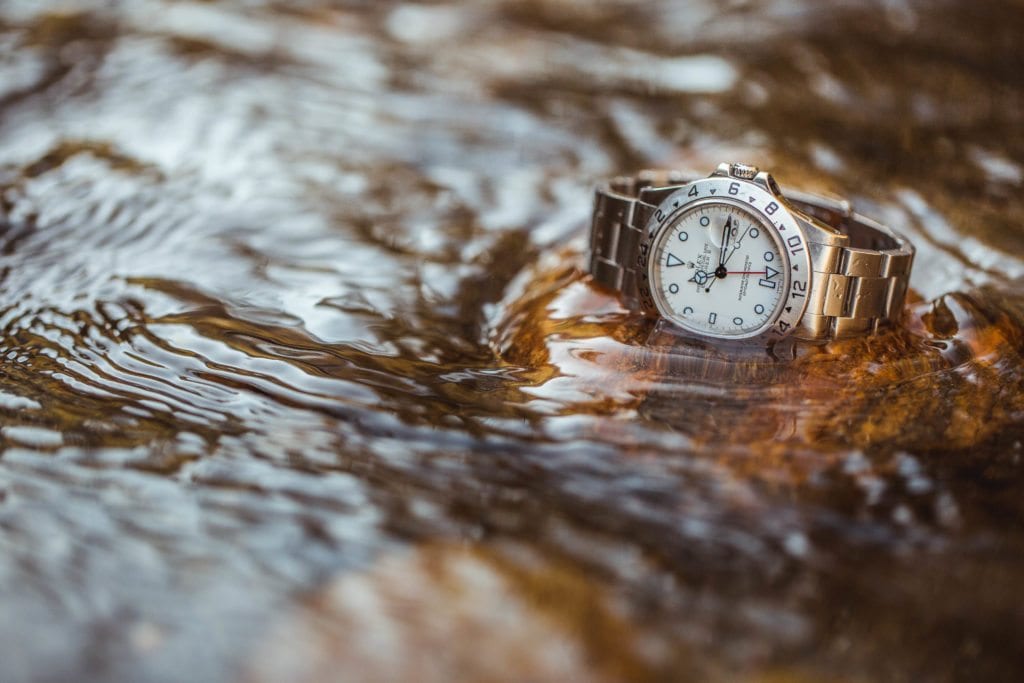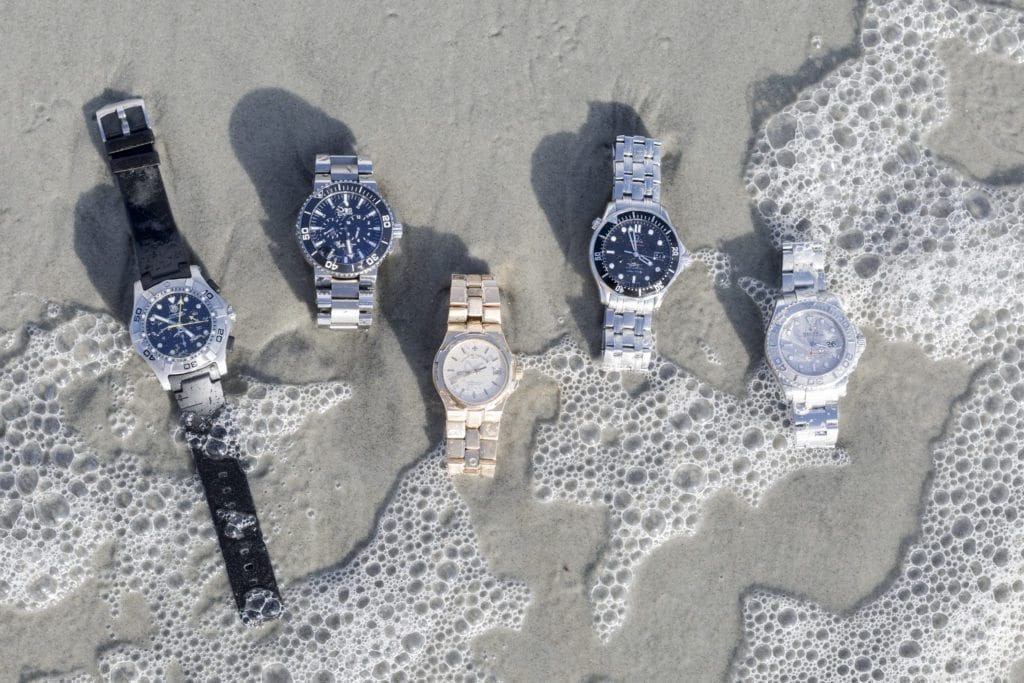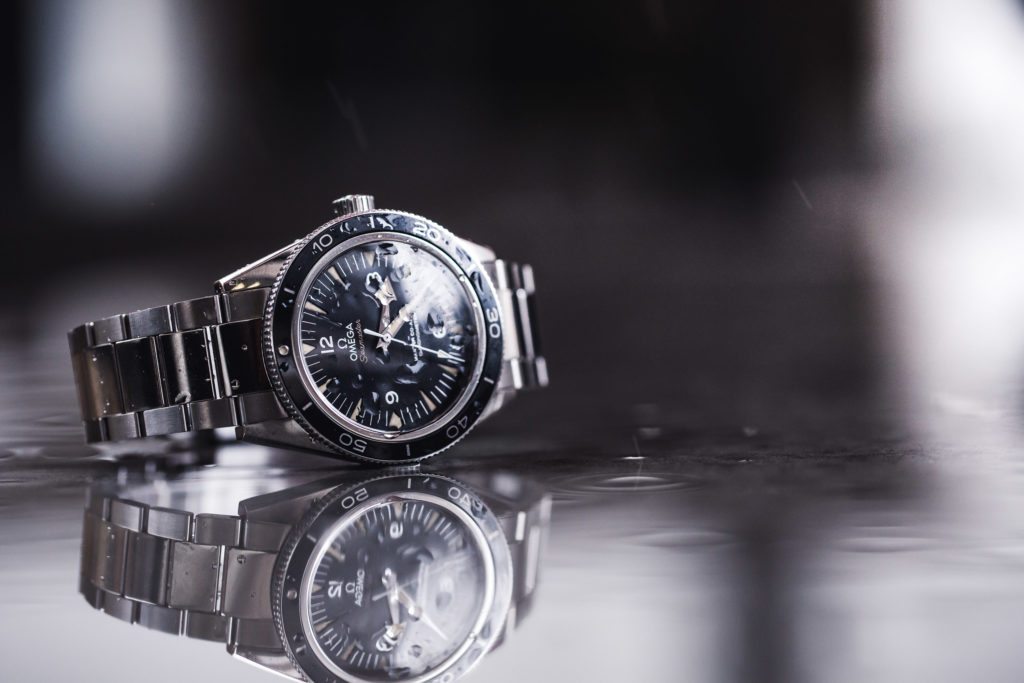What Does Water Resistance Mean?
When you’re shopping for a watch and checking out the specs, you’ve likely seen information about watch water resistance ratings. However, you may still be wondering, what does water resistance mean when it comes to watches? Whether you’re an avid diver or just eager to learn more about your watch and its capabilities, it’s important to understand watch water resistance ratings. This will help you care for your watch from the shower to the deep blue sea and beyond. Water can be a watch’s biggest enemy. We take a look at waterproof vs. water resistant in watches and break down what it all really means.
The Difference Between Water Resistance and Waterproof Watches
One of the biggest points of confusion in the watch community is the difference between a water resistant vs waterproof watch. When watchmakers were first developing water resistance technology, they reserved it for specific models like dive watches. Today, the technology is much more widespread. Now, you’ll find that water resistance is a relatively common feature in most models.
A water resistant vs waterproof watch are two different things. Although the watch world uses the term “waterproof,” no watch can actually be completely waterproof. There are just varying degrees of water resistance. A watch described as water resistant most likely has a relatively low degree of water resistance. It often means it has some moisture protection. For example, say you want to know how to tell if a watch is waterproof. Your average water resistant watch can endure a rain shower but not a dip in a swimming pool.
Older, vintage watches may say “waterproof” on the back. However, around 1990, ISO 22810:2010 prohibited the use of the word “waterproof” when used with watches. They did so to clarify that no watch is truly “waterproof.” With sufficient pressure, every watch will leak. Water resistance itself is a measurement of static pressure at a specified depth. A 30-meter or 3-Bar watch is the minimum standard to receive a label of “water-resistant.” In the real world, this means that water shouldn’t get inside of a watch during a normal day.
At the most basic level, a water resistant watch essentially protects from humidity. However, this doesn’t mean that the watch is safe for activities that introduce dynamic pressures. For example, diving into a pool could result in pressures that far exceed the capabilities of a 30-meter or 3-Bar watch, if even for a brief second. This can cause the seals on the watch to fail and water to enter. It’s recommended that a 30-meter or 3-Bar watch not be submerged in water for any amount of time.
Diving Watches
Some watch styles can endure time in the water. Dive watches feature a high degree of water resistance. A watch must be able to withstand total submersion in water to be a dive watch. Most models that fall under the dive watch category must be able to endure depths of at least 200 meters. Almost all watches include a small gasket or ring made of rubber or silicon. This seals the inside of the watch from the outside around the stem of the crown, pushers, dial, and caseback. However, dive watches contain more advanced water resistance technology. They have fewer openings for water to permeate. In addition, they typically have a screw-down crown and much heavier gaskets around the dial and caseback. If you’re a diver or even an avid swimmer, surfer, or sailor, a diving watch is an ideal option. Still, it’s important to remember that there is in fact no watch that’s totally waterproof. Even in the most advanced dive watch models, there’s a limit to how much water pressure they can bear. They’re not impervious to leaks under any circumstances.

Caring for Your Watch
Now let’s explore how you should care for your watch’s water resistance. Whether your watch encounters a bit of water through daily wear or a full submersion, it’s important to know how to maintain your watch’s water resistance. You should have a watch water resistance test once per year, minimum. We recommend this for normal daily wear only. However, if you’re a diver, swimmer, surfer, sailor, or someone who wears your watch in the water often, you should have a watch water resistance test more regularly. This is particularly imperative if you wear your watch frequently in salt water. Over time, the salt causes corrosion and additional wear and tear on the watch, diminishing the water resistance over time.
If you’re a diver, there are a few other helpful practices when diving with your watch. Prior to any dive, you’ll want to secure the crown and pusher sleeves. To do this, make sure they’re screwed down and properly secured. Don’t operate or attempt to operate the pushers or the crown of the watch while submerged in water. This will introduce water to the inside of the watch. Lastly, it’s important to rinse any dive watch once it’s had exposure to salt or chlorinated water.
What to do if Your Watch is Exposed to Water
All it takes is a single drop of water to do serious damage to the mechanism of your watch. It’s important to take your watch to a certified professional immediately if you notice water inside your watch. This includes droplets or condensation. The longer moisture stays inside a watch, the more damage the watch sustains. Moisture can cause damage to all the internal portions of a watch, including the movement, dial, hands, and luminosity.
Err On the Side of Caution
When in doubt, always err on the side of caution when it comes to your watch and moisture. Simply showering with your watch and exposing it to soap and water could result in water getting in the watch. This alone can cause serious damage. Even if your watch says it has a water resistance up to 100 meters, you should still avoid things like diving in a pool. A watch’s water resistance isn’t just about moisture. It’s about changes in pressure. An act like diving into a pool causes an abrupt change in pressure. This can shock your watch and instantly push it over its water resisting capacity. Fixing water damage can be a costly repair. Therefore, it’s best to take necessary precautions and keep up with regular maintenance so your watch stays in tip top shape.
Get More Articles Like This in Your Inbox
We're constantly creating great content like this. So, why not get it delivered directly to your inbox? By subscribing you agree to our Privacy Policy but you can unsubscribe at any time.







